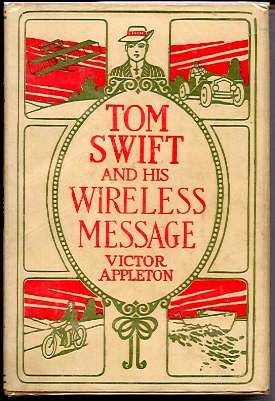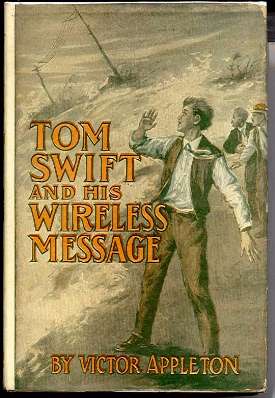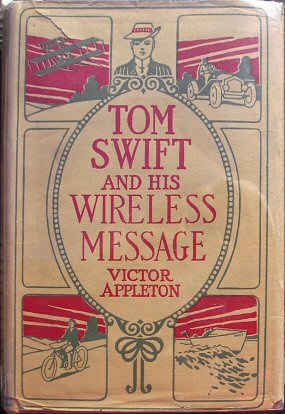
Tom Swift and his Wireless Message
Or, The Castaways of Earthquake Island
by Victor Appleton
White Quad, Brown Quad and Duotone images are from the collection of Mark Snyder
Summary:
None of the original Tom Swift Sr. books came with summaries. However, the events of the book can be summed up as follows:The book starts out when Tom's trusty servant, Eradicate, gives Tom a telegram. The telegram, which was sent by a wealthy inventor, asked Tom Swift to fly up to Philadelphia to help perfect an electric airplane. After discussing the matter over with his father, Tom agreed to help the inventor and he and Mr. Damon flew to Philadelphia.
The inventor's airplane, which was called the Whizzer, was badly built and in need of extensive changes. At first Tom despaired of ever getting it to fly, but after a lot of hard work the plane was overhauled and made air-worthy.
As soon as the overhaul was complete, Tom Swift told Mr. Fenwick that he wanted to take the plane on a trial trip to see how well it performed. After stocking the plane with food, Mr. Fenwick, Tom, and Mr. Damon boarded the plane and started it up. At first the plane could not leave the ground; however, after Tom regeared the motor the lumbering craft rose off the ground, and two days later the trio departed on their journey.
After an uneventful flight to New Jersey, a violent storm that had been brewing hit with full force and carried the aircraft hundreds of miles out to sea. The Whizzer, clumsy and heavy though it was, managed to stay in the air for some time but eventually the aircraft crashed onto a barren island. Nobody was seriously injured as a result of the crash, but the airplane was a complete loss; there was no way that it would ever fly again. The group was marooned!
Soon after the trio had crashed onto the island they discovered that Mr. and Mrs. Nestor -- the parents of Tom's girlfriend -- were also on the island. After talking with the Nestors, Tom discovered that the yacht that they had been on had been beached by of the storm.
The Nestors, however, were not the only people that were on board the yacht when it was marooned. One of the other people that had been on board was a noted disaster-predicting scientist by the name of Mr. Parker. Mr. Parker, true to his character, predicted that the earthquakes that frequently racked the island were going to destroy it soon and kill them all. If that wasn't bad enough, the captain of the yacht said that the island was off the beaten path of ship lanes; the group thus had no chance of being sighted by a ship.
How did the group get off the island before it sank beneath the sea and killed them all? How did Tom Swift save the day? To find out the answers to these questions you'll have to read the book Tom Swift and his Wireless Message.
![]()
Major Inventions

As is sometimes the case in the Tom Swift Sr. series, Tom Swift did not invent anything new in the course of the book. He did, however, have a hand in the construction of two already-invented inventions, and that is what I will talk about here.
The first thing that Tom Swift played a part in was the perfection of Mr. Hosmer Fenwick's electric airplane. The electric airplane is a rather interesting idea that had a simple concept behind it: instead of running on gasoline, this airplane was run by an electric current.
Building an airplane that runs on electricity was no mean feat. An electric airplane poses a number of difficult technical challenges. The inventor overcame these challenges by inventing a motor that uses gasoline to produce an electric current. The electric current is used to power an electric motor, and the electric motor turns the propellers:
÷and Tom and Mr. Damon, looking in, saw a large triplane, with a good-sized gas bag hovering over it, and a strange collection of rudders, wings and planes sticking out from either side. Amidships was an enclosed car, or cabin, and a glimpse into it served to disclose to the young inventor a mass of machinery÷
There was certainly plenty of machinery in the cabin of the Whizzer. Most of it was electrical, for on that power Mr. Fenwick intended to depend to sail through space. There was a new type of gasoline engine, small but very powerful, and this served to operate a dynamo. In turn, the dynamo operated an electrical motor, as Mr. Fenwick had an idea that batter, and more uniform, power could be obtained in this way, the an from a gasoline motor direct. One advantage, which Tom noticed at once, was that the Whizzer, had a large electric storage battery.
This was intended to operate the electric motor in case of a break to the main machinery, and it seemed a good idea. There were various other apparatuses, machines, and appliances, the nature of which Tom could not readily father from a mere casual view.
There is more to consider when building an airplane than just its power source, however, and while the inventor was a whiz at electrical devices, he fell down badly in other areas. At first, in fact, Tom was aghast at all of the changes that needed to be made: not only did the planes need adjusting, the engine itself also needed extensive work:
÷"I think that there is one trouble that we will have to get over," he finally said to Mr. Fenwick.
"What is that?"
"The motor is not quite powerful enough because of the way in which you have it geared up. I think by changing some of the cogs, and getting rid of the off-set shaft, also by increasing the number of revolutions, and perhaps by using a new style carburetor, we can get more speed and power.
÷"Do you think it will work after that?"
"Well," remarked Tom hesitatingly, "I think the arrangement of the planes will also have to be changed. It will take quite some work, but perhaps, after a bit, we can get the Whizzer up in the air."
In the end, of course, Tom Swift did get the Whizzer to fly, although it was a goodly piece of work.

The second invention that the book deals with is the
electric wireless -- or to translate that into modern English, the radio. Now, the book does not claim that Tom Swift either invented or improved the electric wireless. In fact, all he did was simply build one. The building of one, however, was an impressive feat -- after all, not everybody can build a radio out of the wreckage of an airplane.The wireless outfit that Tom built was vastly different from the nice, simple, clean, compact radio sets that we are so familiar with today. In fact, radios have changed so much over the years that I imagine if the average American were to stumble across one he wouldn't have any idea what it was used for. The change in equipment has really been that dramatic.
What were some of the dramatic differences? Well, one of them was the fact that the wireless set Tom built made a horrendous noise:
Suddenly, overhead, there sounded a queer crackling noise, a vicious, snapping, as if from some invisible whips.
"Mercy! What's that?" cried Mrs. Nestor.
"The wireless," replied Tom, quietly.
The book
Tom Swift and his Ocean Airport went even further, stating that the noise made by the average ship's wireless was almost enough to deafen a man. Somewhere down the line, somebody figured a way out to make wireless sets silent and I am very grateful.The wireless station that Tom built also needed a whole host of complex equipment. The purpose of some of this equipment I can readily gather (the key was likely used to send Morse code messages), but some of the equipment completely boggles me (what would carbons and needles be used for, and what in the world is a coherer?):
He related how he had set up the dynamo and gasoline engine, and how, by means of the proper coils and other electrical apparatus, all of which, fortunately, was aboard the Whizzer, he could produce a powerful spark.
"I had to make a key out of strips of brass, to produce the Morse characters," the lad said. "This took considerable time, but it works, though it is rather crude. I can click out a message with it."
"That may be," said Mr. Hosbrook, who had been considering installing a wireless plant on his yatch, and who, therefore, knew something about it, "you can send a message, but can you receive an answer?"
"I have also provided for that," replied Tom. "I have made a receiving instrument, though that is even more crude than the sending plant, for it had to be delicately adjusted, and I did not have just the magnets, carbons, coherers and needles that I needed. But I think it will work."
"Did you have a telephone receiver to use?"
"Yes. There was a small interior telephone arrangement on Mr. Fenwick's airship, and part of that came in handy. Oh, I think I can hear any messages that may come in answer to ours."
"But what about the aerial wires for sending and receiving messages?" asked Mr. Nestor. Don't you have to have several wires on a tall mast?"
"Yes, and that is the last thing to do," declared Tom÷
"Have you got the wire?" asked Mr. Jenks.
"I took it from the stays of the airship," was Tom's reply÷
To further highlight the differences between Tom's wireless and the modern radio, I have copied the passages that deal with the principles by which Tom's wireless worked and posted them here:
 "But I can't understand how you are going to do it," said Mrs. Nestor. "I've read about wireless messages, but I can't get it through my head. How is it done, Mr. Swift?"
"But I can't understand how you are going to do it," said Mrs. Nestor. "I've read about wireless messages, but I can't get it through my head. How is it done, Mr. Swift?"
"The theory is very simple," said the young inventor. "To send a message by wire, over a telegraph system, a battery or dynamo is used. This establishes a current over wires stretched between two points. By means of what is called a 'key' this current is interrupted, or broken, at certain intervals, making the sounding instrument send out clicks. A short click is called a bot, and a long click a dash. By combinations of dots, dashes, and spaces between the dots and dashes, letters are spelled out. For instance, a dot and a space and a dash, represent the letter 'A' and so on."
"I understand so far," admitted Mrs. Nestor.
"In telegraphing without wires," went on Tom, "the air is used in place of a metallic conductor, with the help of the earth, which in itself is a big magnet, or a battery, as you choose to regard it. The earth helps to establish the connection between places where there are no wires, when we 'ground' certain conductors."
"To send a wireless message a current is generated by a dynamo. The current flows along until it gets to the ends of the sending wires, which we have just strung. Then it leaps off into space, so to speak, until it reaches the receiving wires, which we have just strung. Then it leaps off into space, so to speak, until it reaches the receiving wires, wherever they may be erected. That is why any wireless receiving station, within a certain radius, can catch any messages that may be flaying through the air--that is unless certain apparatus is tuned, or adjusted, to prevent this."
"Well, once the impulses, or electric currents, are sent out into space, all that is necessary to do is to break, or interrupt them at certain intervals, to make dots, dashes, and spaces. These make corresponding clicks in the telephone receiver which the operator at the receiving station wears on his ear. He hears the code of clicks, and translates them into letters, the letters into words and the words into sentences. That is how wireless messages are sent."
And do you propose to send some that way?" asked Mrs. Anderson.
"I do," replied Tom, with a smile.
On another note, Tom's wireless set had a rather odd problem: Tom couldn't guarantee that someone could receive a message that he sent out. To find out why, read the following passage:
"Do you mean to say that you can catch messages flying back and forth between stations now?" asked Mr. Fenwick.
"Yes," replied the young inventor, with a smile. "Here, listen for yourself," and he passed the head-instrument over to the Whizzer's former owner. The latter listened a moment.
"All I can hear are some faint clicks," he said.
"But they are a message," spoke Tom. "Wait, I'll translate," and he put the receiver to his ear, "'Steamship "Falcon" reports a slight fire in her forward compartment,'" said Tom slowly. "'It is under control, and we will proceed.'"
"Do you mean to say that was the message you heard?" cried Mr. Damon. "Bless my soul, I never can understand it!"
"It was part of a message," answered Tom. "I did not catch it all, nor to whom it was sent."
"But why can't you send a message to that steamship then, and beg them to come to our aid?" asked Mr. Fenwick. "Even if they have had a fire, it is out now, and they ought to be glad to save life."
"They would come to our aid, or send," spoke Tom, "but I can not make their wireless operator pick up our message. Either his apparatus is not in tune, or in accord with ours, or he is beyond our zone."
"But you heard him," insisted Mr. Damon.
"Yes, but sometimes it is easier to pick up messages than it is to send them. However, I will keep on trying."
It's amazing how much technology has changed, isn't it? Reading the old Tom Swift Sr. series has really given me an appreciation of all the modern gadgets that I've come to take for granted. It also has helped me to grasp how far and how fast we have come. I wonder what people will be taking for granted 100 years from now÷
![]()
Tom Swift and his Electric Runabout | Tom Swift Among the Diamond Makers | Index